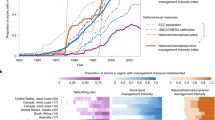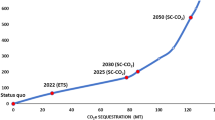Abstract
The United Nations has launched several initiatives to achieve sustainable development, with the most recent being the Sustainable Development Goals within the 2030 Agenda. In a fisheries context, this initiative sets a target of ending overexploitation by 2020. Despite such efforts, the percentage of overfished fish stocks has oscillated around 30% globally since 2009. Here, we show that while developed countries are improving the way they manage their fisheries, developing countries face a worsening situation in terms of overcapacity, production per unit of effort and stock status. This situation is fuelled by economic interdependencies through international trade and fisheries agreements coupled with limited management and governance capacities in developing countries. We conclude that the present successes accomplished in some countries and regions are not sufficient to address the fisheries crisis and achieve the Sustainable Development Goals target globally. We highlight an urgent need to replicate and readapt successful policies and measures in the light of the realities of specific fisheries, and to implement transformational changes in fishery management and governance that influence entire sectors of the economy.
This is a preview of subscription content, access via your institution
Access options
Access Nature and 54 other Nature Portfolio journals
Get Nature+, our best-value online-access subscription
$29.99 / 30 days
cancel any time
Subscribe to this journal
Receive 12 digital issues and online access to articles
$119.00 per year
only $9.92 per issue
Buy this article
- Purchase on Springer Link
- Instant access to full article PDF
Prices may be subject to local taxes which are calculated during checkout



Similar content being viewed by others
References
The Future We Want (United Nations, 2012); https://sustainabledevelopment.un.org/content/documents/733FutureWeWant.pdf
The Millennium Development Goals Report (United Nations, 2015); http://www.un.org/millenniumgoals/2015_MDG_Report/pdf/MDG%202015%20rev%20(July%201).pdf
Transforming Our World: The 2030 Agenda for Sustainable Development (United Nations, 2015); https://sustainabledevelopment.un.org/post2015/transformingourworld
The State of World Fisheries and Aquaculture 2016 (FAO, 2016).
Worm, B. et al. Rebuilding global fisheries. Science 325, 578–585 (2009).
Gutierrez, N. L., Hilborn, R. & Defeo, O. Leadership, social capital and incentives promote successful fisheries. Nature 470, 386–389 (2011).
Bell, J., Watson, W. & Ye, Y. Global fishing capacity and fishing effort from 1950 to 2012. Fish Fish. 18, 489–505 (2017).
Alder, J. & Sumaila, U. R. Western Africa: a fish basket of Europe past and present. J. Environ. Dev. 13, 156–158 (2004).
Eggert, H & Greaker, M. Effects of Global Fisheries on Developing Countries Report No. 393 (University of Gothernburg, 2009).
Hutton, T . et al. in Advances in Fisheries Science (eds Payne, A., Cotter, J. & Potter, T. ) 26–48 (Blackwell, 2008).
Ricard, D., Minto, C., Jensen, O. P. & Baum, J. K. Examining the knowledge base and status of commercially exploited marine species with the RAM Legacy Stock Assessment Database. Fish Fish. 13, 380–398 (2012).
Costello, C. et al. Status and solutions for the world's unassessed fisheries. Science 338, 517–520 (2012).
Review of the State of World Marine Fishery Resources (FAO, 2011).
Smith, M. D. et al. Sustainability and global seafood. Science 327, 784–786 (2010).
Worldwide governance indicators.The World Bank http://data.worldbank.org/data-catalog/worldwide-governance-indicators (2015).
Agnew, D. J. et al. Estimating the worldwide extent of illegal fishing. PLoS ONE 4, e45702009 (2009).
Pitcher, T. J., Kalikoski, D., Pramod, G. & Short, K. Not honouring the code. Nature 457, 658–659 (2009).
Hilborn, R. & Ovando, D. Reflections on the success of traditional fisheries management. ICES J. Mar. Sci. 71, 1040–1046 (2014).
Marchal, P. et al. A comparative review of fisheries management experiences in the European Union and in other countries worldwide: Iceland, Australia, and New Zealand. Fish Fish. 17, 803–824 (2016).
Mulazzani, L. & Malorgio, G. Is there coherence in the European Union’s strategy to guarantee the supply of fish products from abroad? Mar. Policy 52, 1–10 (2015).
Bilateral Agreements with Countries Outside the European Union (European Commission, 2016); http://ec.europa.eu/fisheries/cfp/international/agreements/index_en.htm
Mbithi-Mwikya, S. Fisheries Access Agreements (ICTSD, 2006).
Sumaila, U. R., Lam, V., Le Manach, F., Wartz, W. & Pauly, D. Global fisheries subsidies: an updated estimate. Mar. Policy 69, 189–193 (2016).
Wilson D. et al. (eds) Fishery Status Reports 2008 (Bureau of Rural Sciences and Australian Bureau of Agricultural and Resource Economics, 2009).
Agreement on Port State Measures to Prevent, Deter and Eliminate Illegal, Unreported and Unregulated Fishing (FAO, 2016).
Report of the Expert Consultation on Catch Documentation Schemes (FAO, 2015).
Gutierrez, N. L. et al. The current situation and prospects of fisheries certification and ecolabelling. Fish. Res. 182, 1–6 (2016).
Lubchenco, J., Cerny-Chimana, E. B., Reimera, J. N. & Levin, S. A. The right incentives enable ocean sustainability successes and provide hope for the future. Proc. Natl Acad. Sci. USA 113, 14507–14514 (2016).
Fishstat J – Software for Fishery Statistical Time Series (FAO, 2014); www.fao.org/fishery/statistics/software/fishstatj/en
EUROPA (European Union, 2015); http://ec.europa.eu/fisheries/fleet/
Standard Country or Area Codes Classification for Statistical Use (United Nations Statistics Division, 1999); http://unstats.un.org/unsd/methods/m49/m49.htm
Garibaldi, L. The FAO global capture production database: a six-decade effort to catch the trend. Mar. Policy 36, 760–768 (2012).
Anticamara, J., Watson, R., Gelchu, A., Beblow, J. & Pauly, D. Global fishing effort (1950–2010): trends, gaps, and implications. Fish. Res. 107, 131–136 (2011).
Garcia, S. & Newton, C. in Global Trends: Fisheries Management (eds Pikitch, E. K., Hupper, D. D. & Sissenwine, M. P. ) 3–27 (American Fisheries Society, 1997).
Fitzpatrick, J. Fishing technology, fisheries resources and future demand. In: Proceedings of the World Symposium on Fishing Gear and Fishing Vessel Design, 1988 (The Newfoundland and Labrador Institute of Fisheries and Marine Technology, 1989).
Zhou, S., Buckworth, R. C., Ellis, N., Deng, R. A. & Pascoe, S. Getting all information out of logbooks: estimating banana prawn fishable biomass, catchability, and fishing power increase, with a focus on natural mortality. ICES J. Mar. Sci. 72, 54–61 (2015).
Farmed Seafood Imports to the United States (NOAA, 2015); http://www.fishwatch.gov/sustainable-seafood/the-global-picture
Market Analysis and Research Database (International Trade Centre, 2015).
Acknowledgements
We thank F. Carocci for assistance in extracting data from the FAO databases, and S. Garcia and T. A. Branch for their review and valuable comments on an earlier draft of the manuscript.
Author information
Authors and Affiliations
Contributions
Y.Y. and N.L.G. designed the study, developed the methodology, collected the data, performed the analysis and wrote the manuscript.
Corresponding authors
Ethics declarations
Competing interests
The authors declare no competing financial interests.
Supplementary information
Supplementary Information
Supplementary Methods, Supplementary Tables 2,3, Supplementary Figures 1–4 (PDF 283 kb)
Supplementary Table 1
Fish stocks from the RAM database with information on stock status available (from 2007 to 2014). (XLSX 17 kb)
Rights and permissions
About this article
Cite this article
Ye, Y., Gutierrez, N. Ending fishery overexploitation by expanding from local successes to globalized solutions. Nat Ecol Evol 1, 0179 (2017). https://doi.org/10.1038/s41559-017-0179
Received:
Accepted:
Published:
DOI: https://doi.org/10.1038/s41559-017-0179
This article is cited by
-
A composite fishing index to support the monitoring and sustainable management of world fisheries
Scientific Reports (2023)
-
Diminishing returns on labour in the global marine food system
Nature Sustainability (2023)
-
Widening mismatch between UK seafood production and consumer demand: a 120-year perspective
Reviews in Fish Biology and Fisheries (2023)
-
Expanding ocean food production under climate change
Nature (2022)
-
Fisheries Optimal Harvest Under Price and Biomass Uncertainty
Environmental and Resource Economics (2021)



